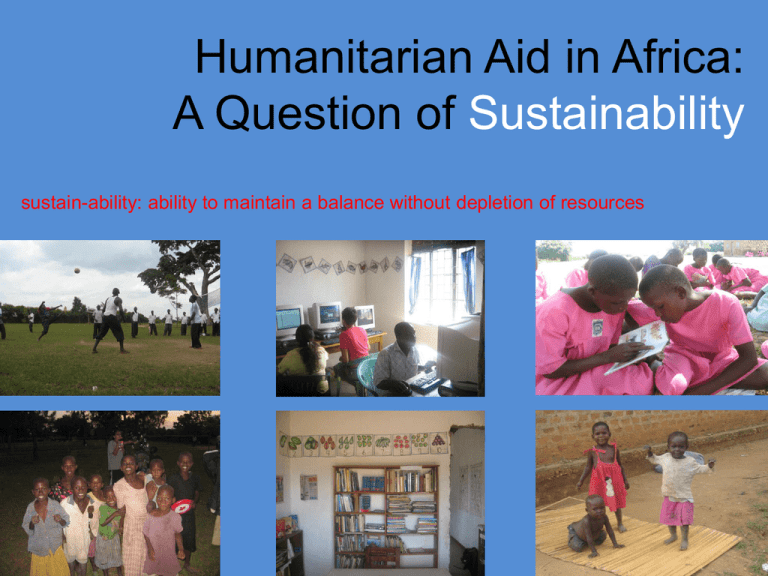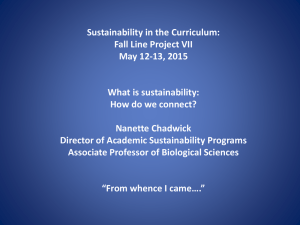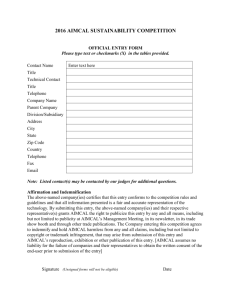Humanitarian Aid in Africa: A Question of Sustainability
advertisement

Humanitarian Aid in Africa: A Question of Sustainability sustain-ability: ability to maintain a balance without depletion of resources THE ETHICS OF INTERNATIONAL ENGAGEMENT AND SERVICE LEARNING PROJECT Purposes of community norms are: • To engage, sustain and deepen conversation. •Ensure safety even when participants may experience discomfort or disagreement. •Support meaningful cross-cultural conversation. -Speak your truth -Ethics is Messy -Expect and Accept Non-Closure EIESL Presentation Focus: to examine the implications of aid and to consider the potential benefits and consequences of it’s perpetuance 1. Understand our motivations for helping • The history of aid • How do we benefit from being aid providers? 2. Examine the +/- ways in which aid influences a community’s political, social and economic practices • Analysis contains key points proposed from the book Dead Aid 3. Discuss the lasting impact of our projects • Examine our community partnerships what do they need from us? • Interactive activity 4. A new direction for sustainability • Visioning: how would it look? Objectives Giver? Receiver? Sustainable? Choose a question that stands out. You have a one minute free write to explain its significance to you personally. Sometimes there are more questions than answers… Do we prioritize others’ needs over our own? Are we helping ourselves? Who is the receiver? Where does the notion of helping come from? Who takes responsibility? Are we helping others? What if there is a better way? How did I become an expert? What skills am I lacking? Who is the giver? Why isn’t aid working? Who sees the benefit? When? History •1960s – The Decade of Industrialization •1970s – The Shift to a Poverty Focus •1980s – The Lost Age of Development •1990s – A Question of Governance •2000s – The Rise of Glamour Aid The “Scar” on the World’s Conscience •Africa’s per capita income is lower than in the 1970s, leaving people in the same level of poverty as 40 years ago •700 million Africans live on less than $1 US dollar per day •Sub-Sarahan has the highest proportion of the world’s poor ~50% •Life expectancy stagnated at ~ 50 years •High child mortality rates 1/7 children dies before the age of five •50% of the continent remains under nondemocratic rule The Developed World’s Response: Aid Three types: 1. Humanitarian or Emergency Aid – aid mobilized and delivered in response to calamities or catastrophes 2. Charity-based Aid – aid dispersed by charitable organizations to people or organizations on the ground 3. Systematic Aid – aid payments made directly to the government An African Economist’s Perspective Dambisa Moyo The Potential Success of Aid 1. Proponents argue the Marshall Plan that dispersed aid to rebuild Europe proves aid can be successful. 2. Past recipient countries of aid have advanced with economic success (i.e. China, Chile, Thailand, South Korea, Turkey, etc.) 3. Conditionalities allow for strategic programs of implementation (i.e. introducing widespread malaria nets) The Potential Consequences of Aid 1. Silent killer of growth creates a vicious cycle of dependency and economic suppression 2. Corruption surrounding aid causes civil strife and prevents stable governments/ democratic rule 3. Conditionalities or “strings” attached to aid often impose cultural or social impracticalities. They can be damaging to current situations and often, due to corruption are ignored regardless. Fitting in this idea of Sustainability sustain-ability: ability to maintain a balance without depletion of resources Unpacking the term -What does sustainability mean to you? -Why is this term loaded? Discussion Is Aid a Sustainable Element of African Culture? Why or why not? Things to consider: -UBC students engaging in ISL projects are contributing resources (financial, time, work) -As ISL becomes more popular, more students become involved in communities around the world This creates an awareness for the issues that affect people and a need to continue “helping” Interactive Activity -We are going to split the table in half and have a debate! -Five minutes to prepare -Everyone to present 1.5-2 min Argument -2 minute rebuttal/questions -1 minute close Conclusion The best time to plant a tree is twenty years ago. The second best time is now. -African proverb -Aid continues to be an important aspect of development -The sustainability of its programs will largely depend on resources (people, money, time, energy) and the manner and consistency of how these resources are distributed











